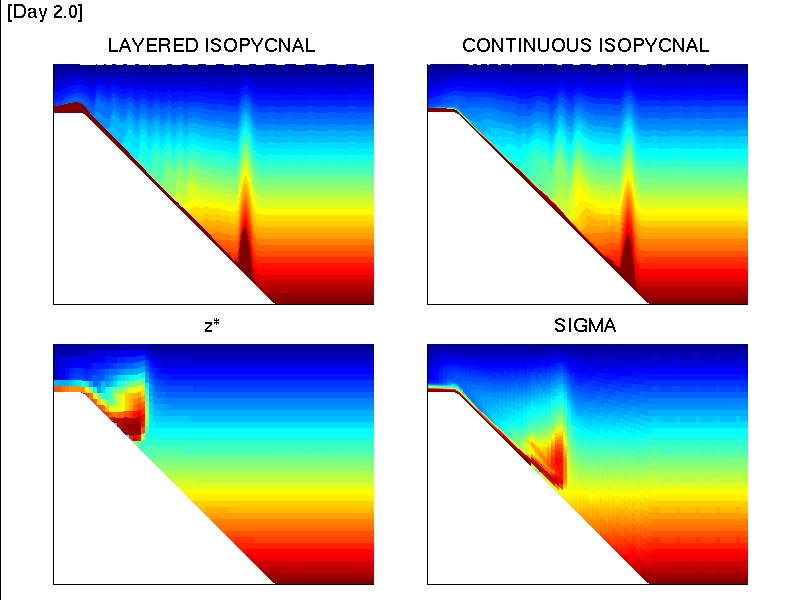Ocean Circulation Models
 Numerical ocean models approximate the real ocean by breaking seawater into finite sized grid boxes, and representing the
exchange of ocean tracers and momentum between these boxes using the equations for fluid flow on a rotating sphere. This work at GFDL originates from the pioneering efforts of the 1960s, with the study of global climate remaining the key focus of GFDL ocean model applications.
Numerical ocean models approximate the real ocean by breaking seawater into finite sized grid boxes, and representing the
exchange of ocean tracers and momentum between these boxes using the equations for fluid flow on a rotating sphere. This work at GFDL originates from the pioneering efforts of the 1960s, with the study of global climate remaining the key focus of GFDL ocean model applications.
While ocean models start with the same continuous equations, the discrete equations possess important distinctions that play a role in the simulation features. Different parts of the ocean are most naturally represented using different coordinate systems. Level-coordinate models consider each box is at the same level. These models are relatively easy to code and have been the basis for ocean climate modeling since the 1960s. Such models may also have particular advantages in representing the transition between the poorly stratified mixed layer and the interior ocean where flow is predominantly along density surfaces. In contrast, isopycnal models handle the interior ocean more naturally, and may also have significant advantages in representing thin overflows. In shallow coastal regions, where the top and bottom boundary layers are thought to be most important, many oceanographers use terrain-following coordinate systems. For more discussion, see Griffies et al.
In 2005, we embarked on two parallel and complementary paths. The first focused the numerical and physical enhancement of our workhorse ocean model, the Modular Ocean Model (MOM). The second prototypes a new generation of ocean model for the study of climate, whose Lagrangian vertical coordinate is based on density layers, rather than depth or pressure levels used in MOM. Being able to simulate the ocean climate system using two distinct and complementary ocean model classes is unique to GFDL. It provides us with important tools to establish robust features of the climate simulations, such as the response of the Atlantic Meridional Overturning Circulation in a warming planet.
MOM
The Modular Ocean Model (MOM) is the canonical ocean climate model use by many researchers around the world. The model origins date back to the community code first developed by Kirk Bryan and Mike Cox in the 1960's-1980's, and to which many other ocean climate models can trace their origins.
- MOM3 is a z-coordinate model released in 1999. It is no longer supported by GFDL, though the MOM3 manual can be downloaded here (~5Mb).
- MOM4.0 presents an extensive update in parameterizations and streamlined capabilities relative to MOM3. There were four sub-releases of this code during the period Jan2004 until May2005. Click here for the MOM4.0 manual (~2Mb).
- MOM4.1 is a reformulation of MOM4.0 that was released late 2007 (click here for the MOM4.1 manual: ~7Mb). We anticipate a new release May2009. This code allows for the following added functionality relative to MOM4.0:
- the inclusion of non-Boussinesq effects (relevent for studying sea-level)
- alternative vertical coordinates such as p* and z*.
HIM
The Hallberg Isopycnal Model is, as the name suggests, an isopycnal layered model. It has the distinct advantage of having no spurious diapycnal fluxes (e.g. spurious diffusion of heat) which is hypothesized to be prevalent in many ocean models.
GOLD
The development of HIM has been subsumed by the development of a prototype hybrid-coordinate model (internally referred to as GOLD, Generalized Ocean Layer Dynamics). GOLD represents an exploration into new general coordinate techniques that can take advantage of hybridizing different coordinate systems in particular parts of the water column. GOLD is being used with an isopycnal coordinate as the ocean component of CM2G and ESM2G (physical climate and earth system models). GOLD is currently capable of working in geo-potential (z*), terrain-following (σ), layered isopycnal and a continuous isopycnal (ρ) coordinates. Evaluation of the impact of coordinates on model solutions is ongoing (see figure above).
Next Generation Ocean Model
While MOM and GOLD are distinct developments and fundamentally differ in formulation, the vision for the next generation modular ocean model will blend these two disparate approaches together over the next development cycle. This next generation model has not been named. This model will incorporate all the new coordinate work represented by MOM4p1 and GOLD and possibly include multiple horizontal grid types (B and C grids). The model will likely have new physics (including non-hydrostatic terms) and the software may look more like a library than a single source code. It will be both a completely new model and yet be configurable to recover its predecessors.

